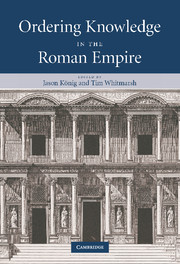Book contents
- Frontmatter
- Contents
- Preface
- Notes on contributors
- List of abbreviations
- Part I INTRODUCTION
- Part II KNOWLEDGE AND TEXTUAL ORDER
- 2 Fragmentation and coherence in Plutarch's Sympotic Questions
- 3 Galen and Athenaeus in the Hellenistic library
- 4 Guides to the wor(l)d
- 5 Petronius' lessons in learning – the hard way
- 6 Diogenes Laërtius, biographer of philosophy
- 7 The creation of Isidore's Etymologies or Origins
- Part III KNOWLEDGE AND SOCIAL ORDER
- Bibliography
- Index
2 - Fragmentation and coherence in Plutarch's Sympotic Questions
Published online by Cambridge University Press: 28 August 2009
- Frontmatter
- Contents
- Preface
- Notes on contributors
- List of abbreviations
- Part I INTRODUCTION
- Part II KNOWLEDGE AND TEXTUAL ORDER
- 2 Fragmentation and coherence in Plutarch's Sympotic Questions
- 3 Galen and Athenaeus in the Hellenistic library
- 4 Guides to the wor(l)d
- 5 Petronius' lessons in learning – the hard way
- 6 Diogenes Laërtius, biographer of philosophy
- 7 The creation of Isidore's Etymologies or Origins
- Part III KNOWLEDGE AND SOCIAL ORDER
- Bibliography
- Index
Summary
READING MISCELLANISM
This volume attempts to draw out some of the ordering principles which lie beneath the surface of the Roman Empire's compilatory writing. The difficulty of identifying any such principles is particularly acute for works which have a strongly miscellanistic quality. I should say at the outset that it is hard to isolate any clearly bounded ancient genre of the ‘miscellany’. It seems more fruitful instead to recognise the recurring presence of a range of miscellanistic characteristics across many different kinds of writing. Miscellanistic works – in the sense in which I understand that term here – are marked primarily by the disparateness of the material they accumulate. In some cases that quality of disparateness is supplemented by other markers: for example, many miscellanistic texts claim that their primary aim is to give pleasure to their readers’, rather than to instruct or to be comprehensive; many make claims about the randomness of their own structures. Sometimes, for sure, all of these characteristics are combined with each other. Moreover, in some cases we find authors situating their own texts in relation to other miscellanistic writing. For example, Aulus Gellius, Attic nights pr. 4–10, not only chooses a title which evokes the idea of variety (the many different nights the author has spent in reading and compiling), but also compares his title with the titles other miscellanistic writers have chosen, in a way which suggests a high degree of self-consciousness about his work's place among a series of other similar texts.
- Type
- Chapter
- Information
- Ordering Knowledge in the Roman Empire , pp. 43 - 68Publisher: Cambridge University PressPrint publication year: 2007
- 9
- Cited by



